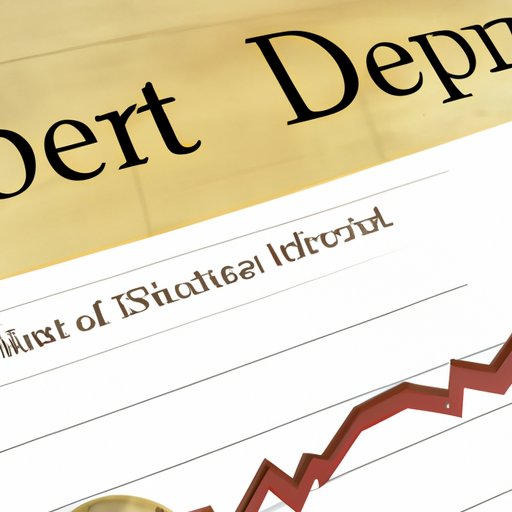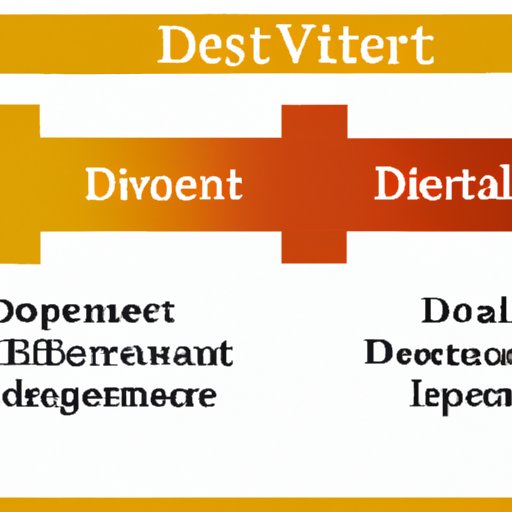Introduction
Debt can be a major obstacle in achieving financial freedom. While it’s important to pay off debt, there may be times when investing with debt makes more sense. The decision to invest with debt should be carefully considered and researched, as there are both advantages and disadvantages to this approach. In this article, we’ll explore the pros and cons of investing with debt, as well as strategies for minimizing risk and debunking common myths about investing with debt.

Analyzing the Pros and Cons of Investing with Debt
Investing with debt involves taking out a loan or using credit cards to make investments. Many people view this as a risky strategy, but there are actually some advantages to investing with debt. Let’s take a closer look at the pros and cons of investing with debt.
Advantages of Investing with Debt
The main advantage of investing with debt is that it allows you to leverage your money. When you borrow money to invest, you can potentially earn a higher return on your money than if you had invested without leveraging. This is because you are able to invest more money than you would have otherwise been able to. Another advantage of investing with debt is that you can often deduct the interest payments from your taxes, which can help reduce your overall tax burden.
Disadvantages of Investing with Debt
The primary disadvantage of investing with debt is the risk involved. When you borrow money to invest, you are taking on additional risk. If the investment doesn’t perform as expected, you could end up losing more money than you initially borrowed. Additionally, if the investments don’t perform well, you could be stuck paying back the loan with money that you don’t have. This can create a difficult financial situation.

Exploring Investment Strategies for People with Debt
If you decide to invest with debt, there are several strategies you can use to minimize risk. First, it’s important to select investments that offer a good return potential and low risk. For example, investing in stocks or mutual funds is generally safer than investing in real estate or commodities. Additionally, it’s important to diversify your investments so that you’re not putting all of your eggs in one basket.
Types of Investments to Consider
When investing with debt, it’s important to choose investments that offer a good return potential and low risk. Stocks, exchange-traded funds (ETFs), mutual funds, and bonds are all good options. Real estate and commodities can also be good investments, but they tend to be riskier than stocks and bonds. Additionally, it’s important to research each investment carefully before committing any money.
Strategies to Minimize Risk
It’s important to diversify your investments in order to minimize risk. Diversification means spreading your money across different types of investments, such as stocks, bonds, ETFs, and mutual funds. Additionally, it’s important to set stop-loss orders on your investments in order to limit your losses if the market turns against you. Finally, it’s important to keep your debt payments manageable so that you don’t overextend yourself financially.
Examining the Risks Involved in Investing with Debt
Investing with debt carries certain risks that must be taken into account. These risks include financial risk, market risk, and interest rate risk. Financial risk refers to the possibility of losing money due to poor investment performance. Market risk is the risk of losing money due to fluctuations in the stock market. Interest rate risk is the risk of losing money due to changes in interest rates.
Financial Risk
Financial risk is the risk of losing money due to poor investment performance. When investing with debt, it’s important to select investments that offer a good return potential and low risk. This will help minimize the financial risk associated with investing with debt.
Market Risk
Market risk is the risk of losing money due to fluctuations in the stock market. When investing with debt, it’s important to diversify your investments and set stop-loss orders in order to limit your losses if the market turns against you.
Interest Rate Risk
Interest rate risk is the risk of losing money due to changes in interest rates. When investing with debt, it’s important to select investments that offer a good return potential and to monitor interest rates closely. This will help minimize the interest rate risk associated with investing with debt.
Debunking Common Myths about Investing with Debt
There are many misconceptions about investing with debt. Let’s take a look at three common myths and examine why they’re false.
Myth 1: Investing with Debt is Risky
Investing with debt does carry certain risks, but it can also be a viable strategy for those who are willing to do their research and manage their investments carefully. When done correctly, investing with debt can be a safe and profitable way to grow your wealth.
Myth 2: Paying off Debt is Always Better than Investing
Paying off debt is certainly important, but it’s not always the best option. In some cases, investing with debt can be a better choice. It’s important to consider your individual circumstances and goals when deciding whether to pay off debt or invest.
Myth 3: You Can’t Make Money with Debt
This is simply not true. Investing with debt can be an effective way to generate returns, as long as you manage your investments carefully and stay within your risk tolerance. Additionally, you can often deduct the interest payments from your taxes, which can help reduce your overall tax burden.

Investigating the Impact of Interest Rates on Investing with Debt
Interest rates play a significant role in the success of investing with debt. Low interest rates can make investing with debt more attractive, while high interest rates can make it less appealing. Let’s take a look at how low and high interest rates can impact investing with debt.
Low Interest Rates
Low interest rates make borrowing money to invest more attractive. When interest rates are low, you can borrow money at a lower cost, which can increase your potential return on investment. Additionally, the interest payments on the loan may be tax-deductible, which can further increase your return.
High Interest Rates
High interest rates make borrowing money to invest less appealing. When interest rates are high, you have to pay more to borrow money, which can significantly reduce your potential return on investment. Additionally, the interest payments on the loan may not be tax-deductible, which can further reduce your return.
Assessing the Benefits of Paying off Debt Before Investing
Paying off debt can be beneficial for those who are considering investing with debt. Let’s take a look at the short-term and long-term benefits of paying off debt before investing.
Short-Term Benefits
In the short term, paying off debt can free up money that can be used to invest. Additionally, it can reduce your monthly payments, which can give you more financial flexibility. Finally, it can reduce stress and anxiety related to debt, which can improve your overall quality of life.
Long-Term Benefits
In the long term, paying off debt can save you money in interest payments. Additionally, it can help improve your credit score, which can open up new opportunities for borrowing money in the future. Finally, it can provide peace of mind knowing that you are no longer burdened by debt.

Comparing Investing with Debt to Other Financial Strategies
Investing with debt is only one of many financial strategies available. Let’s take a look at how investing with debt compares to other strategies, such as investing in stocks, real estate, and mutual funds.
Investing in Stocks
Investing in stocks can be a great way to grow your wealth over time. Stocks tend to be less risky than other investments, and they offer the potential for higher returns. Additionally, you can often deduct the interest payments from your taxes, which can help reduce your overall tax burden.
Investing in Real Estate
Investing in real estate can be a great way to generate income and build wealth. Real estate is typically more volatile than other investments, so it’s important to do your research and manage your investments carefully. Additionally, you can often deduct the interest payments from your taxes, which can help reduce your overall tax burden.
Investing in Mutual Funds
Investing in mutual funds can be a great way to diversify your investments and minimize risk. Mutual funds are professionally managed and often offer a good return potential. Additionally, you can often deduct the interest payments from your taxes, which can help reduce your overall tax burden.
Conclusion
Investing with debt can be a viable strategy for those who are willing to do their research and manage their investments carefully. There are both advantages and disadvantages to investing with debt, and it’s important to understand the risks involved. Additionally, it’s important to pay off debt before investing, as this can provide both short-term and long-term benefits. Finally, it’s important to compare investing with debt to other financial strategies in order to determine which strategy is best for you.
In conclusion, investing with debt can be a viable strategy for those who are willing to do their research and manage their investments carefully. However, it’s important to understand the risks involved and to pay off debt before investing. Additionally, it’s important to compare investing with debt to other financial strategies in order to determine which strategy is best for you.
Call to Action
If you are considering investing with debt, it’s important to do your research and understand the risks involved. Additionally, it’s important to pay off your debt before investing and to compare investing with debt to other financial strategies. By taking these steps, you can ensure that you are making the most informed decision possible.
(Note: Is this article not meeting your expectations? Do you have knowledge or insights to share? Unlock new opportunities and expand your reach by joining our authors team. Click Registration to join us and share your expertise with our readers.)
